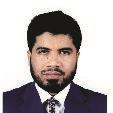
M. M. Hafizur Rahman
Work place: Dept. of Computer Science, KICT, International Islamic University Malaysia Selangor, Malaysia
E-mail: hafizur@iium.edu.my
Website:
Research Interests: Distributed Computing, Computer Networks, Computer Architecture and Organization, Computer systems and computational processes
Biography
M. Hafizur Rahman received his B.Sc. degree in Electrical and Electronic Engineering from Khulna University of Engineering and Technology (KUET), Khulna, Bangladesh, in 1996. He received his M.Sc. and Ph.D. degree in Information Science from the Japan Advanced Institute of Science and Technology (JAIST) in 2003 and 2006, respectively. Dr. Rahman is now an assistant professor in the Dept. of Computer Science, KICT, IIUM, Malaysia. Prior to join in the IIUM, he was an associate professor in the Dept. of CSE, KUET, Khulna, Bangladesh. He was also a visiting researcher in the School of Information Science at JAIST and a JSPS postdoctoral research fellow at Research Center for Advanced Computing Infrastructure, JAIST \& Graduate School of Information Science (GSIS), Tohoku University, Japan in 2008 and 2009 \& 2010-2011, respectively. His current research include parallel and distributed computer architecture, hierarchical interconnection networks and optical switching networks. Dr. Rahman is member of IEICE of Japan and IEB of Bangladesh.
Author Articles
Recognizing Bangla Handwritten Numeral Utilizing Deep Long Short Term Memory
By Mahtab Ahmed M. A. H. Akhand M. M. Hafizur Rahman
DOI: https://doi.org/10.5815/ijigsp.2019.01.03, Pub. Date: 8 Jan. 2019
Handwritten numeral recognition (HNR) has gained much attention in present days as it can be applied in range of applications. Research on unconstrained HNR has shown impressive progress in few scripts but is far behind for Bangla although it is one of the major languages. Bangla contains similar shaped numerals which are difficult to distinguish even in printed form and this makes Bangla HNR (BHNR) a challenging task. Our goal in this study is to build up a superior BHNR framework and consequently explore the profound design of Long Short Term Memory (LSTM) method. LSTM is a variation of Recurrent Neural Network and is effectively used for sequence ordering with its distinct features. This study considered deep architecture of LSTM for better performance. The proposed BHNR with deep LSTM (BNHR-DLSTM) standardizes the composed numeral images first and then utilizes two layers of LSTM to characterize singular numerals. Benchmark dataset with 22000 handwritten numerals having various shapes, sizes and varieties are utilized to examine the proficiency of BNHR-DLSTM. The proposed method indicates agreeable recognition precision and beat other conspicuous existing methods.
[...] Read more.Convolutional Neural Network based Handwritten Bengali and Bengali-English Mixed Numeral Recognition
By M. A. H. Akhand Mahtab Ahmed M. M. Hafizur Rahman
DOI: https://doi.org/10.5815/ijigsp.2016.09.06, Pub. Date: 8 Sep. 2016
Recognition of handwritten numerals has gained much interest in recent years due to its various potential applications. Bengali is the fifth ranked among the spoken languages of the world. However, due to inherent difficulties of Bengali numeral recognition, a very few study on handwritten Bengali numeral recognition is found with respect to other major languages. The existing Bengali numeral recognition methods used distinct feature extraction techniques and various classification tools. Recently, convolutional neural network (CNN) is found efficient for image classification with its distinct features. In this paper, we have investigated a CNN based Bengali handwritten numeral recognition scheme. Since English numerals are frequently used with Bengali numerals, handwritten Bengali-English mixed numerals are also investigated in this study. The proposed scheme uses moderate pre-processing technique to generate patterns from images of handwritten numerals and then employs CNN to classify individual numerals. It does not employ any feature extraction method like other related works. The proposed method showed satisfactory recognition accuracy on the benchmark data set and outperformed other prominent existing methods for both Bengali and Bengali-English mixed cases.
[...] Read more.Bangla Handwritten Character Recognition using Convolutional Neural Network
By Md. Mahbubar Rahman M. A. H. Akhand Shahidul Islam Pintu Chandra Shill M. M. Hafizur Rahman
DOI: https://doi.org/10.5815/ijigsp.2015.08.05, Pub. Date: 8 Jul. 2015
Handwritten character recognition complexity varies among different languages due to distinct shapes, strokes and number of characters. Numerous works in handwritten character recognition are available for English with respect to other major languages such as Bangla. Existing methods use distinct feature extraction techniques and various classification tools in their recognition schemes. Recently, Convolutional Neural Network (CNN) is found efficient for English handwritten character recognition. In this paper, a CNN based Bangla handwritten character recognition is investigated. The proposed method normalizes the written character images and then employ CNN to classify individual characters. It does not employ any feature extraction method like other related works. 20000 handwritten characters with different shapes and variations are used in this study. The proposed method is shown satisfactory recognition accuracy and outperformed some other prominent exiting methods.
[...] Read more.Other Articles
Subscribe to receive issue release notifications and newsletters from MECS Press journals